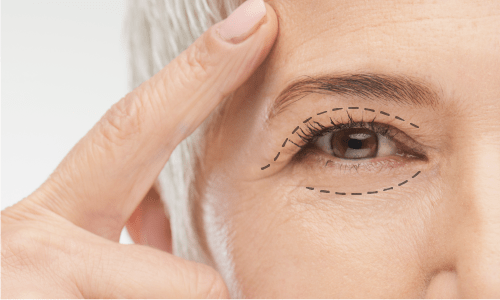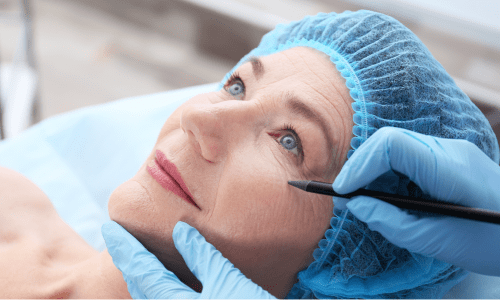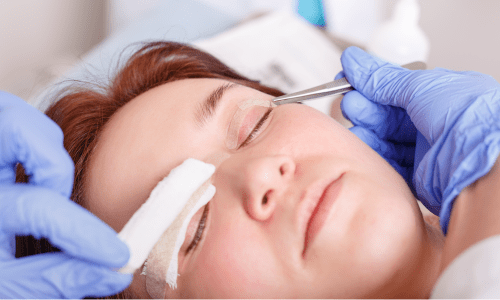Blepharoplasty / Blepharoplasty
What is blepharoplasty, or eyelid surgery?
Blepharoplasty, better known as eyelid surgery, is an oculoplasty surgical procedure that involves removing excess fat, skin or muscles from the upper or lower eyelids, as this can give the appearance of aging or tiredness, and may even affect vision.
Blepharoplasty does not remove wrinkles or treat any other symptoms of aging. It can be performed on its own, but it may also be used to complement other facial cosmetic procedures, such as those designed to remove loose skin, rejuvenate the face or remove blemishes.

Who is the ideal candidate for a blepharoplasty?
→ Eyelid surgery, or blepharoplasty, is intended for patients who are looking to enhance, rather than drastically change, the appearance of their face, whether it be for aesthetic or other reasons.
→ Patients who undergo this procedure are usually 40 or older. Younger patients may require the surgery in exceptional cases if they are genetically predisposed to develop bags under the eyes.
→ If the patient suffers from thyroid disease, lack of tears, high blood pressure, cardiovascular disease, glaucoma or diabetes, they should consult with their oculoplastic surgeon about the feasibility of performing blepharoplasty, as these medical conditions could lead to complications.

Types of blepharoplasty
Upper eyelid blepharoplasty
Upper eyelid blepharoplasty is a type of surgery performed by making micro-incisions along the natural folds of the upper eyelids in order to remove excess skin and fat caused by aging. The objective of this procedure is to make the eyes look more rejuvenated and less tired.
Subciliary blepharoplasty
In a subciliary blepharoplasty procedure, the incision is made below the lash line. The purpose of this surgery is to reduce bags under the lower eyelids by removing some of the fat that has built up inside. This approach is also suitable for cases requiring skin removal.
It is usually performed under local anaesthesia and a sedative, and does not require a hospital stay.
Lower eyelid blepharoplasty
Lower eyelid blepharoplasty is a type of surgery that is used to remove excessive skin from the lower eyelid.
It is an operation for removing bags under the eyes and can often also be used to improve under-eye wrinkles by repositioning the fat, to make the area around the eyes look clearer and younger.
There are various techniques available for performing this procedure and the specialist ophthalmologist should select the most suitable based on the patient’s needs.
Transconjunctival blepharoplasty
The main difference between this procedure and subciliary blepharoplasty is where the incision is made. For transconjunctival blepharoplasty, the surgeon makes the incision between the eyelids and the eyeball.
This technique is more common for patients who do not have saggy eyelid skin or muscles, and whose bags are not very pronounced. It is designed for younger patients.
One of the advantages of this procedure is that the skin is left untouched during the surgery, so no stitches are required. This means recovery will be faster and there will be no skin scarring. The entry point made via the conjunctiva is closed without stitches.
The procedure is becoming increasingly common for lower eyelid blepharoplasty surgery. It is performed using local anaesthetic and there is no need for a hospital stay.
Diagnostic process for blepharoplasty
In the initial consultation we will assess the necessary clinical parameters to ensure that the patient is a suitable candidate. A relationship shall be established between the doctor and the patient, where both parties will exchange clear information the disorder and their expectations. The doctor will give the patient a detailed explanation of what the procedures in question involve.
• The position of the eyebrow will be assessed.
• Palpebral parameters shall be measured to rule out associated palpebral ptosis.
• The position of the lower eyelid will be assessed, as well as its flaccidity.
• The sensitivity of the cornea shall be determined.
• A biomicroscopic examination will be performed on the cornea surface to rule out any eye disorders (e.g., dry eye) that could require special consideration when planning the surgery.
• The back of the eye will be examined.
What does eyelid surgery involve?
Eyelid surgery, or blepharoplasty, lasts approximately one hour. Should the oculoplastic surgeon need to operate on all four eyelids, they will always start with the upper lids, making an incision in order to remove the excess skin and create tension in the orbicularis muscle.
When the lower eyelids are particularly flaccid, the incision will usually be made under the eyelids, using very fine stitches that will heal perfectly and that will be practically invisible 3 months after the surgery. In addition to removing fat and sometimes skin, the lower eyelid will be repositioned to reduce the flaccidity of the eyelid.

Post-operative care after blepharoplasty
Your oculoplastic surgeon will advise you on appropriate medication to relieve the pain that you may feel initially. Depending on the surgeon’s preference, they may advise the use of compressive bandages on both eyes for the first 24 hours.
An ophthalmic ointment and cold saline dressings are usually applied to reduce discomfort and inflammation.
The initial symptoms after eyelid surgery are usually excessive eye watering, extreme sensitivity to light and some changes to visual acuity, which will subside in a few days. The patient will be able to return to normal life in 2-3 days. However, they will need to protect their face with large sunglasses for up to two months after the procedure, and also use sun cream with a high factor.
They should also avoid the use of makeup for ten days after the surgery. Blepharoplasty is a type of surgery with long-lasting results that will remain for years to come.
Blepharoplasty: before and after
Over the years, the smooth and lively area around our eyes can lose clarity due to the loss of skin elasticity, which results in an apparent increase of skin on the eyelids or the appearance of bags of fat in the lower and/or upper eyelids that make our eyes appear dark and sad.
This is often also accompanied by wrinkles, such as crow’s feet. In some cases, patients have so much excess skin that their field of vision may also be affected.
This process can also be accelerated by excessive exposure to the sun, certain skin disorders or hereditary factors. Some young people between the ages of 20 and 30 undergo surgery early because they develop bags under the eyes for genetic reasons. However, blepharoplasty can achieve fantastic results, returning a younger and fresh appearance to their face, with long-lasting results.
In short, it is one of the most popular forms of orbital palpebral cosmetic surgery for helping to rejuvenate the eyes.
Upper lower blepharoplasty
Cost of blepharoplasty surgery
The cost of blepharoplasty surgery will depend on the technique that the specialist ophthalmologist (oculoplastic surgeon) advises for each patient. As such, after the required pre-operative tests and a suitable diagnostic process, the clinic will provide a personalised quote for the procedure in question.
If you would like further information about non-surgical cosmetic facial treatments, you can find out more from our Facial and Periocular Cosmetic Treatment Unit, which offers treatments for facial rejuvenation, loose skin on the face and removal of blemishes.



